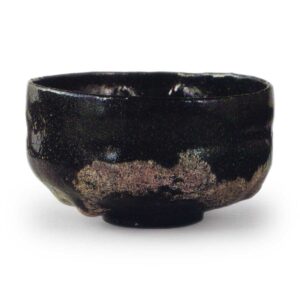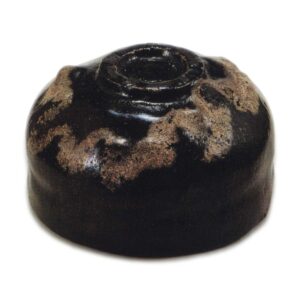

Height: 7.1cm
Diameter: 12.2-12.5cm
Outer diameter of foot ring: 5.1cm
Height of foot ring: 0.5-0.6cm
The makuyu glaze that Nonko is known for hangs down from the waist to the hem of the tea bowl, and the surface of the drooping end of the glaze
is whitish and bubbly, creating the effect known as the snake-brown glaze. The rough texture of the glaze is likened to the raging waves that crash against the rocks, and the name Araiso was given to the tea bowl.
The entire surface is covered in a jet-black glaze, so it is difficult to see the texture of the clay, but in some places where the glaze is thin, the white clay can be seen faintly shining through. After the Nongou period, white clay was often used for the base of black tea bowls, as the firing temperature for Kurogaku was slightly higher, and this was apparently to withstand this. The base is generally finished thinly, with a low waist and a round shape, and the sides rise straight up from the waist to the rim. The width of the body is noticeably larger than the height, giving it a relaxed, stable appearance. The foot ring has been precisely trimmed, and the five-pronged foot ring is still visible on the wide, flat base. The non-kou yuin, the mark of the potter, is stamped on the inside of the foot ring. It is said that the five peaks of the mouth are the beginning of the Nongou, but here they are almost unchanged and smoothly finished, and the sides only show a slight constriction in the middle of the body and a very gentle undulation on the entire surface. However, the surface changes dramatically from the waist to the area around the foot of the bowl. This is not a change in the clay body, but a significant unevenness and change in the glaze surface that has appeared due to the violent flow of the glaze. There are quite a few examples of makie glaze on Nongou, but I think that there are probably no other examples of this type of condition.
The black glaze is a deep black that is a new innovation for Nongou, and it has a moist glaze tone that Chojiro did not have.
The glaze has a beautiful sheen and sometimes shines with a jewel-like iridescence. Here, Nongou’s specialty of layering the glaze and letting it drip down is boldly used. Normally, the flow of this glaze would stop at the waist, but in this teacup, it goes too far, flowing down below the waist and around the hem, and in some places it even reaches the foot ring. In addition, the tips here and there are in a strange undulating state, as if they were about to drip. Furthermore, at the edges of the curtain glaze, which moves in and out violently, there are abnormal areas that look like coarse bubbles, and these run continuously around the base of the cup. These areas are called nonko’s snake-brown glaze, and are generally admired when they appear as a decorative feature on one part of the tea bowl. This phenomenon is said to occur when a glossy glaze is mixed with the high-quality Kamogawa stone, or so-called Kamo black, which is used in the production of Kurogaku ware. In other words, it is thought that the impurities on the glaze surface are washed away by the running curtain glaze, and then accumulate in place, so it is an unexpected and abnormal phenomenon that has arisen from the technique of non-glaze ware. Here, it appears even more intensely, and is likened to the scenery of a rocky beach, and as a non-kou black tea bowl, it shows the ideal iridescent glaze of the gemstone medicine, and as a very rare piece, it is something that should be especially treasured.
The accompanying item is a plain paulownia wood box with a white wood lid. The inside of the lid is inscribed with the words “Nonkou black tea bowl (signature) Araiso”. The origin of the item is unknown. It is currently in the collection of a certain family in the Kansai region.



